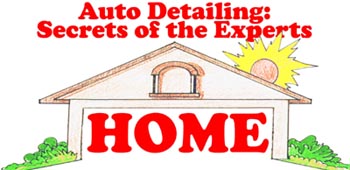|
Unless you never drive your car, small rocks and other debris will chip your paint.
It's unavoidable and frustrating, since the scars are too small to justify painting the
affected area, but they are still noticeable. Fortunately, touching up the paint can be
done on a Do-It-Yourself basis. It takes a bit of patience, but the results are worth it.
Materials
- Nick Sander (or equivalent). Best described as "coarse sandpaper on a pen" it gives you the ability to focus the preparation of the surface.
- 1000, 2000 and 3000 grit wet/dry sandpaper. Unigrit Sanding blocks from Mequiars work well.
- Touch-up paint. Do not buy from auto parts stores; they tend to sell paint that is a compromise (one color fits all!?!?!?) and the chances of getting a good match are poor. We sometimes have had good results from OEM paint purchased at a car dealer, although even they can get into the "we stock 'close enough' paint" trap. Do not use paint that is more than six months old. We have found an excellent source to be paintscratch.com. It's their main business and they do it well; in one test their sample was closer to the car color than paint purchased at a dealer with the manufacturers logo on the label. Their web site also has excellent instructions and information.

- Wax remover, available at your local auto paint store.
- Cleaner.
- Your favorite automotive polish.
- Your favorite automotive wax.
Start by washing the car (or at least the affected area) and then cleaning the area with the
wax remover. Next treat the area with the Nick Sander, (above, left) making sure that all the adjacent area paint that is not well bonded with the body surface is removed.
The next step is to apply the paint. There are any number of methods such as brushes inside the cap of the paint bottle, etc. Our preferred method is to pour a small amount of paint into a small dish and then use the paper end of a cardboard match stick to apply the paint. Other detailers have found that a toothpick works well. Another applicator is small detail brushes purchased at artist supply stores. Be sure to shake the paint thoroughly. Apply it in 2 or 3 layers, building it up so that it is well above the surface of the surrounding paint. If the damage is on a vertical surface, you'll want to protect the area below by applying only small amounts of paint, allowing it to dry (about 1/2 hour+) between applications, and using masking tape and paper to prevent dripping. Allow 24 hours to dry.
You'll then want to sand and polish the paint. Start with the 1000 grit sand paper or the K1000 sanding block (soak them all in water overnight) and sand VERY GENTLY. Inspect your progress often (this is where the patience part is important) and move on to the K2000 and then K3000 sanding blocks until the surface of the touch-up paint and the surrounding paint is even. The area will have a dull finish from the sandpaper, which is taken care of by the Meguiars Fine Cut Cleaner. Finish the job by polishing and waxing the area.
This may seem like a lot of work, but the results are impressive. In the case of the ding on this Mazda Miata, you would be hard pressed to tell where the repair was made unless it was pointed out to you.
Notes
- Light (such as white) colored cars are difficult to get a good color match, while dark colored cars (black for example) are the easiest. We've even seen respectable results using a "Magic Marker" pen on a black car. The "Classic Red" on the Mazda Miata in the sample here was a dark color, so the color match was good.
- In the case of this Miata, even after a week of drying, the touch-up paint was soft, especially compared to the surrounding areas. In the first attempt, We easily sanded to below the surface, and found that the K3000 sanding block was all We really needed. At almost $15 for each sanding block, we could have easily saved some valuable beer money! Your results, of course, may vary.

|


























